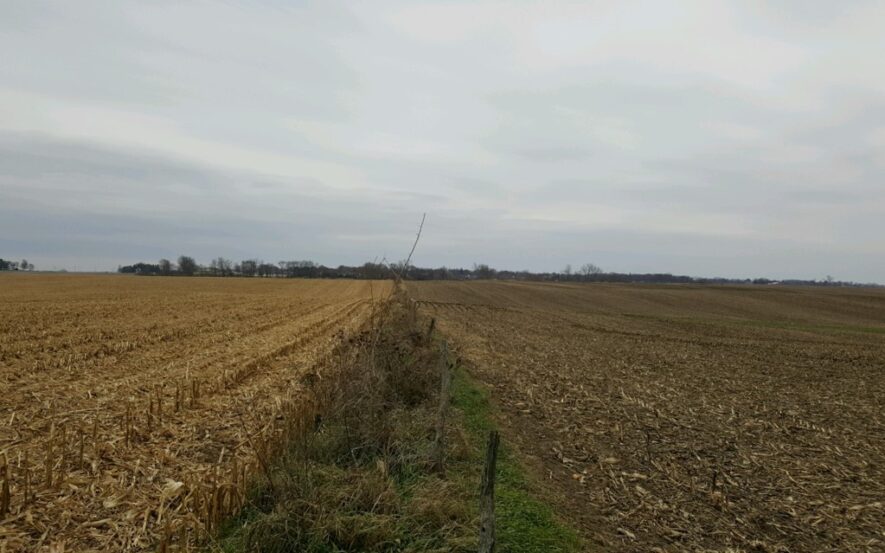By Jerry Hartsock & Dakota Miller
Cutting Edge Consulting & Research Services
As we get further into harvest and closer to the “spooky” season, we believe there are certain considerations to think about so that we do not have any nightmares from 2024 that continue to haunt us into the 2025 growing season. As we like to see it, your plan at harvest is not only reaping your work and effort for one season, but it is also setting up the planter that will roll in 2025.
It all starts right now with even residue distribution during harvest. In no-till situations, it is critical to have all combine settings fine-tuned to minimize field losses and get maximum residue distribution. If residue is only spread part of the distance of the head (much more noticeable with large soybean heads) creating uneven distribution across the field, it results in inconsistent moisture and temperature. This can lead to uneven residue breakdown and an inconsistent planting environment which has major consequences on stand establishment.
Keep in mind as we go through harvest that residue breakdown dramatically decreases as we get closer to and past Halloween. As we slip into a cooler weather pattern, microbial activity that assists in breakdown will slow down until it ceases at 43˚ F and colder. For this reason, we like to follow behind the combine with a true vertical tillage tool that will size up and beat up the residue which puts it in close contact with the microbes. While temperatures are still inviting for microbial activity, we want to increase residue breakdown leading to higher organic matter, more nutrient release, and a more ideal environment for the planter to do its job to our expectations. Planters today do a phenomenal job in a firm, level seed bed. These vertical tillage tools work great to size up residue in the fall and to level the seed bed in the spring. However, if you have compaction lurking somewhere vertical tillage tools are not the piece of equipment to turn to.

Earlier harvest not only results in higher yields coming from the field this year, but sets up the planter for much more success next season with more residue breakdown and nutrient release.
Compaction is a SERIOUS concern in parts of the Cornbelt this year where tillage or planting did not occur in ideal, fit conditions. Compaction WILL haunt you next season if it is not taken care of this fall. Most people have compaction to some degree – whether that is a few end rows or high traffic areas from loading trucks during harvest. Some farmers have whole fields that need addressed. We really like using an in-line ripper to lift and fracture across the soil profile while still maintaining residue on the soil surface. There are other tools that can be used to fix more shallow compaction layers; however, if there are deep compaction layers we will need something to fracture across the whole profile at those lower depths. An anhydrous knife can help take out some minor compaction as well. Taking out compaction layers is a necessity for better root penetration which leads to a better factory of a plant to handle stress and significantly increase yield (both in corn and soybeans). Releasing compaction from the soil profile opens space up for more oxygen that’s necessary for roots, microbes, and bacteria to grow and function properly.
As we consider other factors from 2024 that could haunt us into 2025, there are a couple other notes to take before we get out of the fields. Fields that had greater field losses or suffered more lodging, etc. will need to be noted as possible areas where volunteer corn could be an issue next season. If that field goes back to corn and it was not Vorceed® Enlist® or PowerCore® Enlist® corn this season, there are some exciting technologies we can utilize with those new traits to control volunteer corn in next year’s crop. Also, if there were certain farms where weed control was more problematic this year and more weeds went to seed than in the past it is important to note what fields/areas and what weed pressures there were to form a weed management plan this winter to target those specific areas.
If you have not made them already, now is the time to make lime and dry fertilizer decisions which will help drive your yields next season. We can do this by referencing accurate soil test data to make these key, high dollar decisions. We believe you need to pull soil samples and ensure more cores are being pulled at a consistent 8” depth across the entire grid/management zone. Also keep in mind that if you are in an area considered in a drought, dry soil conditions can affect soil test readings, especially potassium and pH levels.
We may not be happy with what the crop prices are as that is out of our control, but yield is in our control when we have the right plan to have as many bushels to market as possible. Hopefully you have a great crew surrounding you and challenging you to push yields, be more detail-oriented, and always think like a 300+ bpa corn farmer and a 100+ bpa soybean farmer. Your AgVenture Yield Specialist is someone who has the will and ability to be one of the people on your crew to help you make key planning and in-season management decisions. Don’t forget it’s also great time to get early seed orders submitted for possible discounts which your AgVenture Yield Specialist can also guide you on. Find your AgVenture Yield Specialist.
Have a safe and successful finish to harvest season!
Opinions expressed and any recommendations mentioned are of Cutting Edge Consulting & Research Services and its employees.